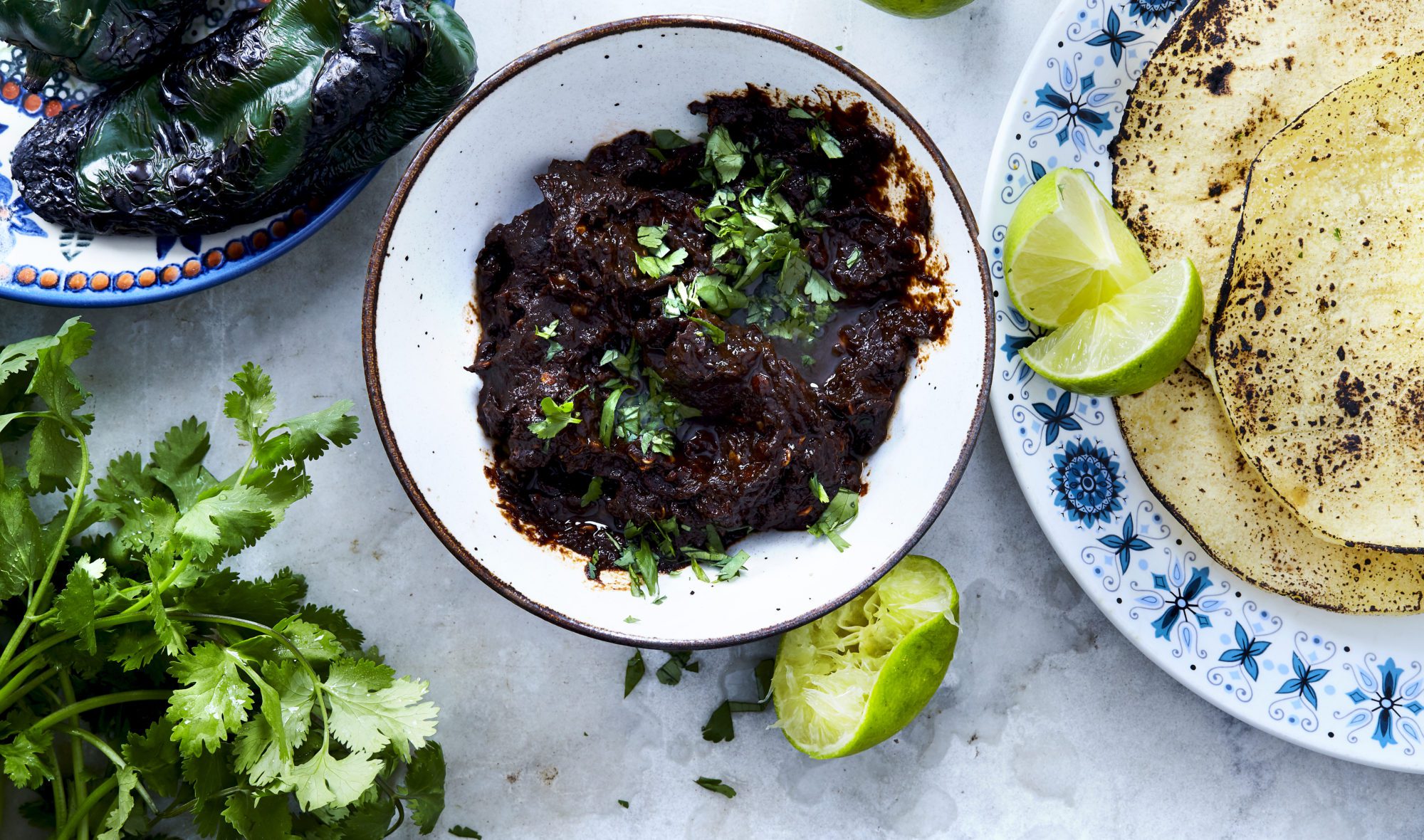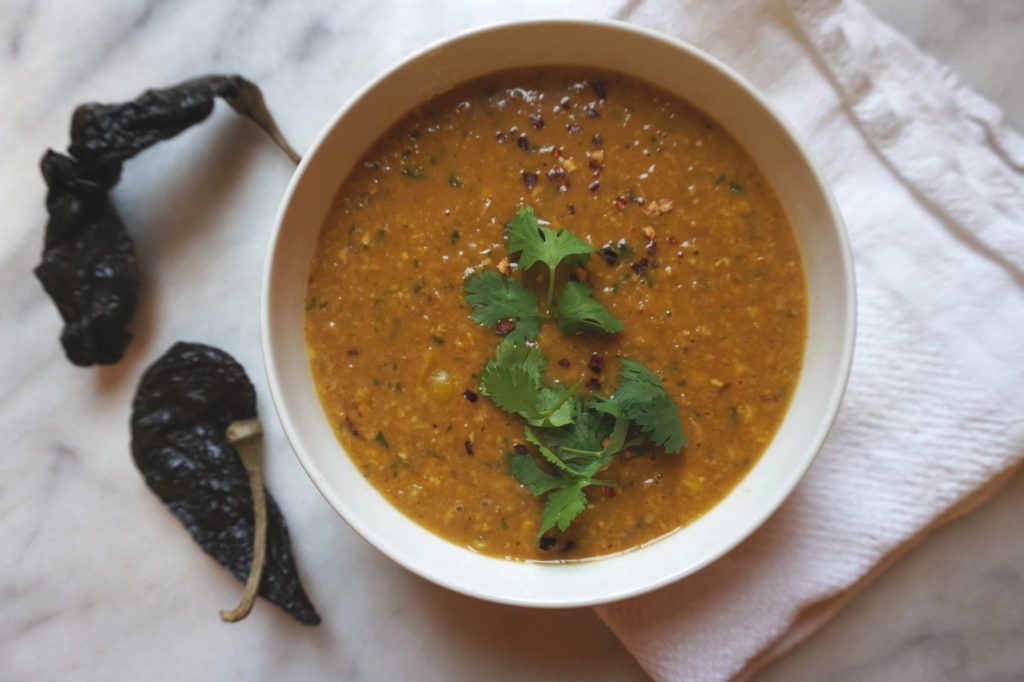
💥 Lowest price possible: on the Nutrition Coach Starter Package. Limited # left.

Dark, small, and wrinkled, the pasilla chile is aptly named after the Spanish word for “little raisin”. And indeed, it has a flavor similar to raisins too. Pasilla chile is the dried version of the chilaca chile pepper, a species of pepper native to Mexico. In its dried version, it has wrinkled brownish-black skin and a long, skinny, tapered shape. Strangely, pasilla chile is often confused with another iconic Mexican pepper, the ancho pepper, and is sometimes mislabeled as such. Luckily, they both have similar flavors and can be used almost interchangeably. Pasillas come up fairly low on the Scoville scale, a ranking system for peppers. At 1,000-3,999 Scoville heat units, most babies and grandparents can handle a pinch of pasilla.
Dark, small, and wrinkled, the pasilla chile is aptly named after the Spanish word for “little raisin”.
Pasilla chile is the dried version of the chilaca chile pepper, which, along with spices like cayenne and paprika, is a species of Capsicum annuum.
Pasilla chiles originated in Mexico, and are often used in traditional recipes. In fact, they are part of the holy trinity of chiles in mole, a savory sauce that also includes ancho and chipotle chiles.
In their fresh form, chilaca chiles have a long and slightly twisted shape, and range from dark green to brown when fully ripe. As they dry, they shrink, harden, darken in color, and intensify in flavor.
Strangely, pasilla chiles are often confused with ancho peppers and are sometimes mislabeled as such.
An obvious way to tell the difference:
Ancho peppers, which are the dried versions of poblano peppers, are wide and flat, with a reddish-black color. Pasilla peppers are long and narrow, with a brownish-black color.
However, if you accidentally buy one instead of the other, anchos and pasillas are close enough in flavor that your recipe will still fly.
Pasillas come up fairly low on the Scoville scale, a ranking system for peppers. At 1,000-3,999 Scoville heat units, most babies and grandparents can handle a pinch of pasilla.
Pasilla pepper is a dried chile pepper with wrinkled brownish-black skin and a long, skinny, tapered shape. Typically, pasillas are sold whole, with their stems intact and seeds still within. Both of these bits are unpalatable, so discard them before consuming.
Pasilla gets its name from the Spanish word for “little raisin”, and indeed, it has a flavor similar to raisins. In addition, pasillas also bear a slight smokey flavor with a hint of cocoa and a mild heat.
Pasilla chile, in the amounts typically consumed, is not a significant source of any nutrients.
Primarily, like most spices, pasilla chiles are used for their bold flavor rather than their nutrient content.
Pasilla chiles are usually sold whole. They may be found packaged in sealed bags, or loose in bulk bins.
Depending on where you are in the world, pasillas may be easy to find or not. In Mexico and many parts of the United States, pasillas may be found at many grocery stores. If not, try to find a Mexican specialty grocery store in your area, or buy them from a trusted purveyor on the internet.
As with all spice shopping, select stores with a high product turnover. Spices that stay on the shelves for long periods of time lose flavor and potency.
Good quality dried pasillas should be found mostly unbroken and unblemished, with a pungent, fruity aroma, and a deep, glossy brownish-black color. The peppers should bend a bit before snapping. If they are very brittle and crumble easily, they may be old.
Pasilla chiles should be stored in a sealed container at room temperature, ideally away from heat and light, such as a closed cupboard or drawer away from the oven.
Like most spices, pasilla chile won’t so much “go bad” as it will lose potency, which will start to occur after about six months when stored as above. You can extend this lifespan to a year by storing it in the freezer.
Whole dried pasilla chiles require a bit of preparation before using, primarily so as to remove the inedible bits (seeds and stems). After they are prepared, they can be added to salsas, marinades, soups, or other dishes.
Before adding dried pasilla to food, first cut off the stems, and then slice or crush the pepper roughly down the middle. Remove the seeds. Chop the pepper into tiny pieces, and sprinkle into your recipe of choice.
Pasilla chiles can also be reconstituted, thereby softening them so they are easier to chop or puree before mixing them into recipes. To do this, pour boiling water into a large bowl, and place the pasillas in the bowl, ensuring that they are fully immersed. Let them sit for about 15 minutes, then drain the water, and pat the chiles dry. Cut the tough stems off, scrape out the seeds, and then chop the softened peppers into desired pieces, and add to your recipe of choice.

Sweet and creamy corn form the base of this dairy-free chowder, accented by spicy and smoky pasilla chile, and fresh cilantro.
Prep Time: 20 minutes Cook Time: 30 minutes Yield: 6 servings
First re-hydrate the chiles: Place pasilla chiles in a bowl and cover with boiling water. Let sit for 5 minutes, then drain. Remove the stems and seeds, and then mince the softened flesh. Set aside.
In a large pot over medium-high heat, add olive oil and heat to a sizzle. Add onion, garlic, yellow peppers, and jalapeño pepper, and cook until vegetables are slightly softened, about 5-7 minutes. Add minced pasilla chile, corn niblets, seasonings, and cook for an additional 5 minutes, stirring intermittently. Add broth, coconut milk, lime juice, and honey, and bring to a simmer. Allow to simmer for about 10 minutes.
Remove from heat, and add cilantro. Then, using an immersion blender, or working in batches with a blender, puree mixture to desired texture. You can process it until it’s nearly smooth, or leave it a little bit chunky.
Serve hot, with a few sprigs of fresh cilantro leaves, and enjoy.
Precision Nutrition’s Encyclopedia of Food expands every single month as we highlight new foods and showcase beautiful food photography. If you’d like to stay up to date, simply click this link. From there, we’ll send you a FREE copy of our recipe book. We’ll also let you know when new and delicious foods are added to the site.
Dark, small, and wrinkled, the pasilla chile is aptly named after the Spanish word for “little raisin”. And indeed, it has a flavor similar to raisins too. Pasilla chile is the dried version of the chilaca chile pepper, a species of pepper native to Mexico. In its dried version, it has wrinkled brownish-black skin and a long, skinny, tapered shape. Strangely, pasilla chile is often confused with another iconic Mexican pepper, the ancho pepper, and is sometimes mislabeled as such. Luckily, they both have similar flavors and can be used almost interchangeably. Pasillas come up fairly low on the Scoville scale, a ranking system for peppers. At 1,000-3,999 Scoville heat units, most babies and grandparents can handle a pinch of pasilla.